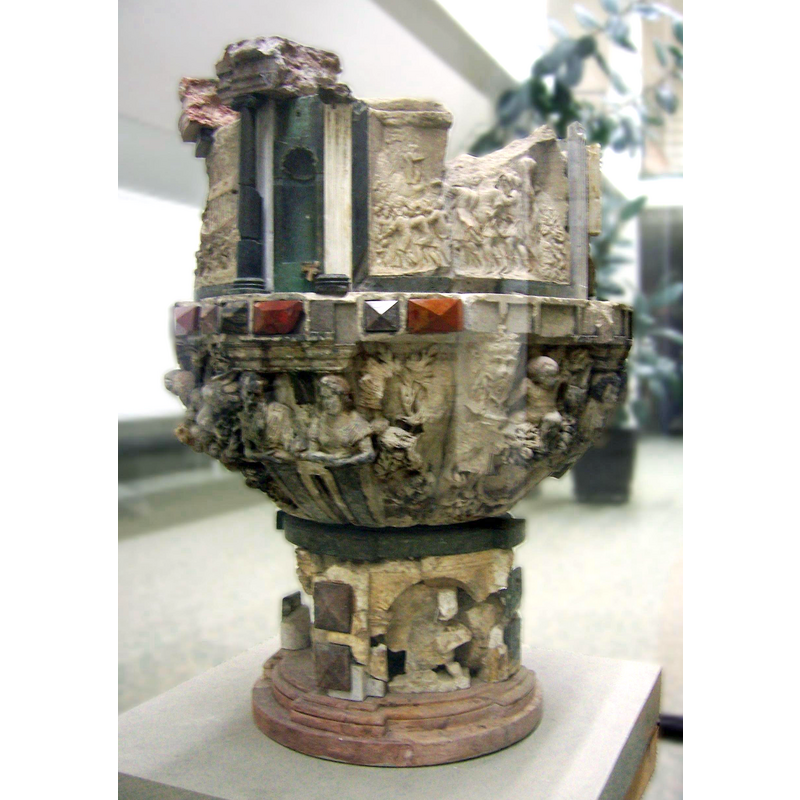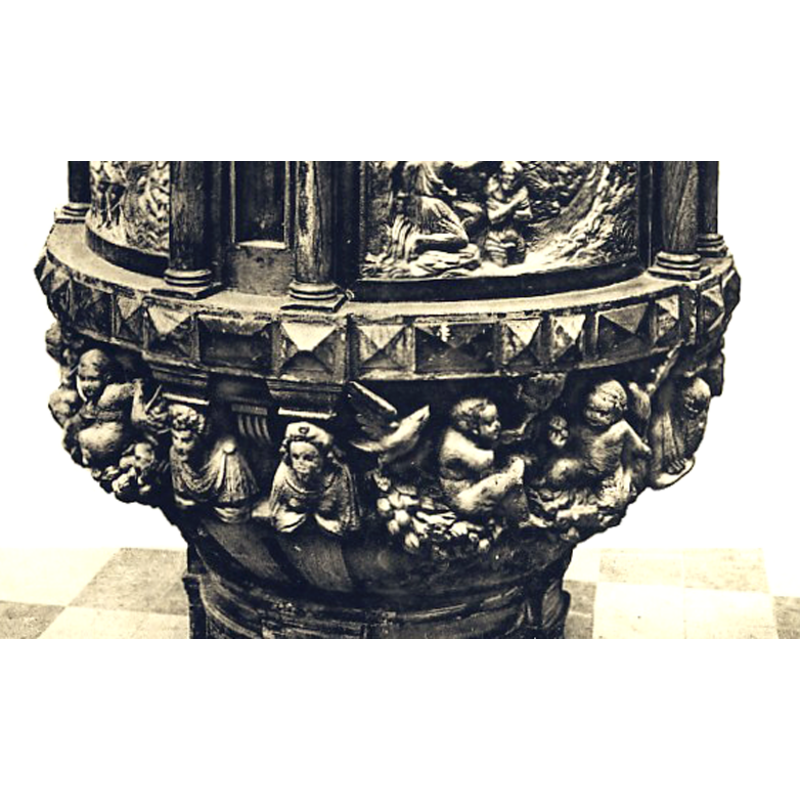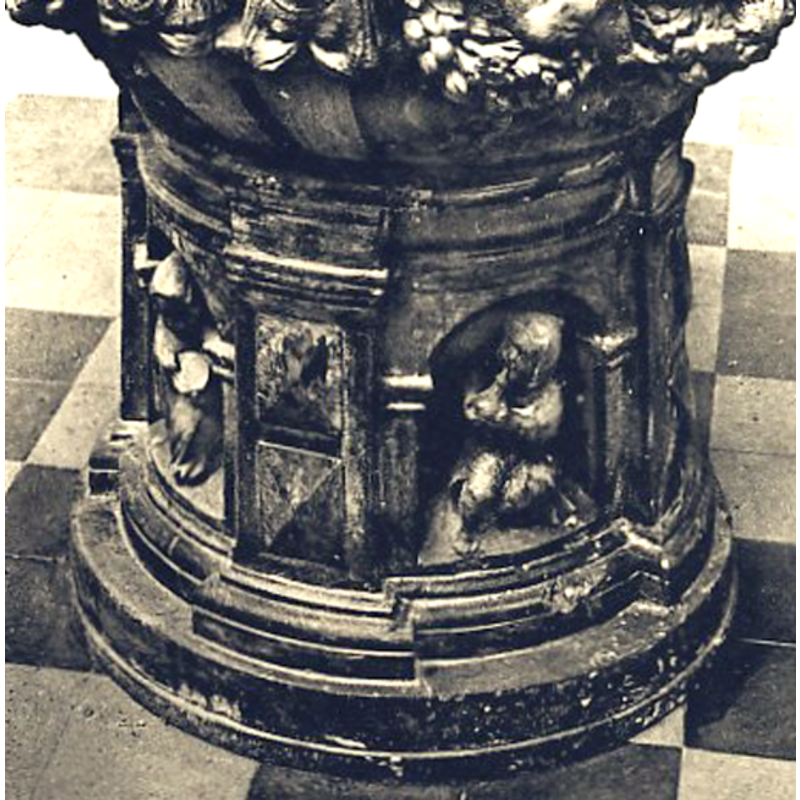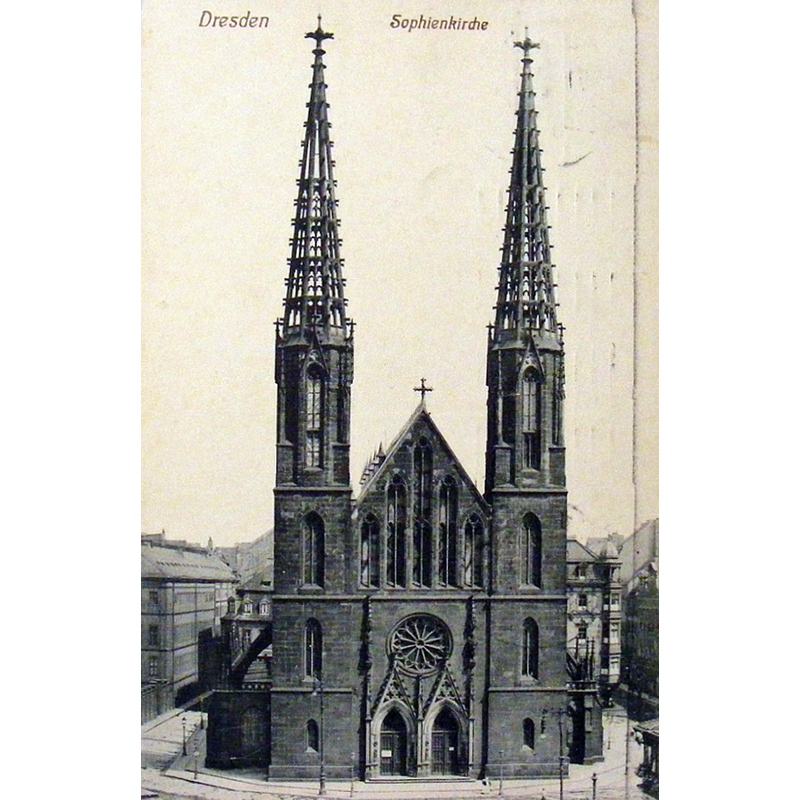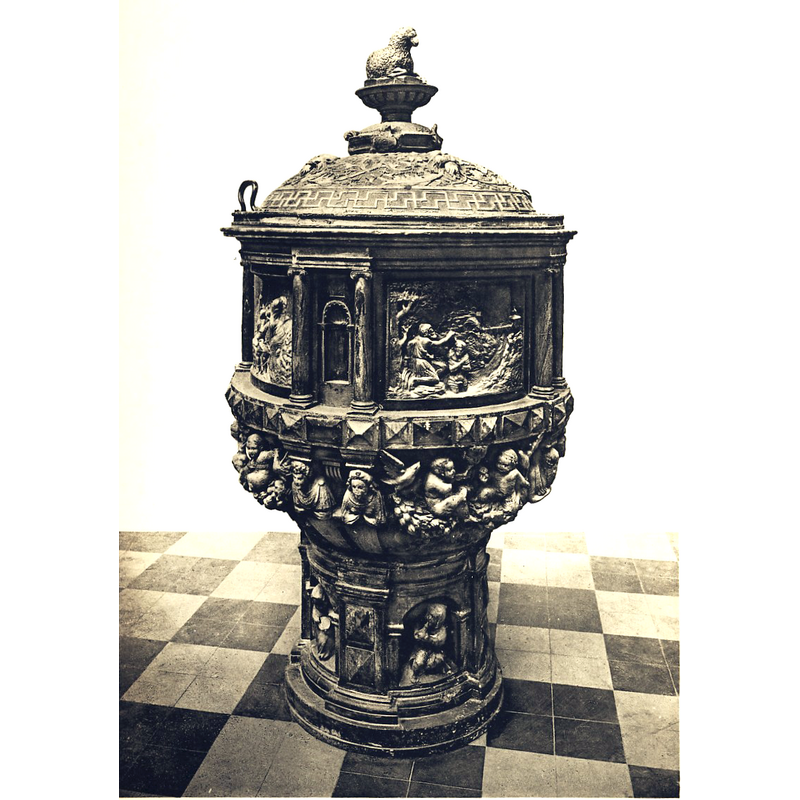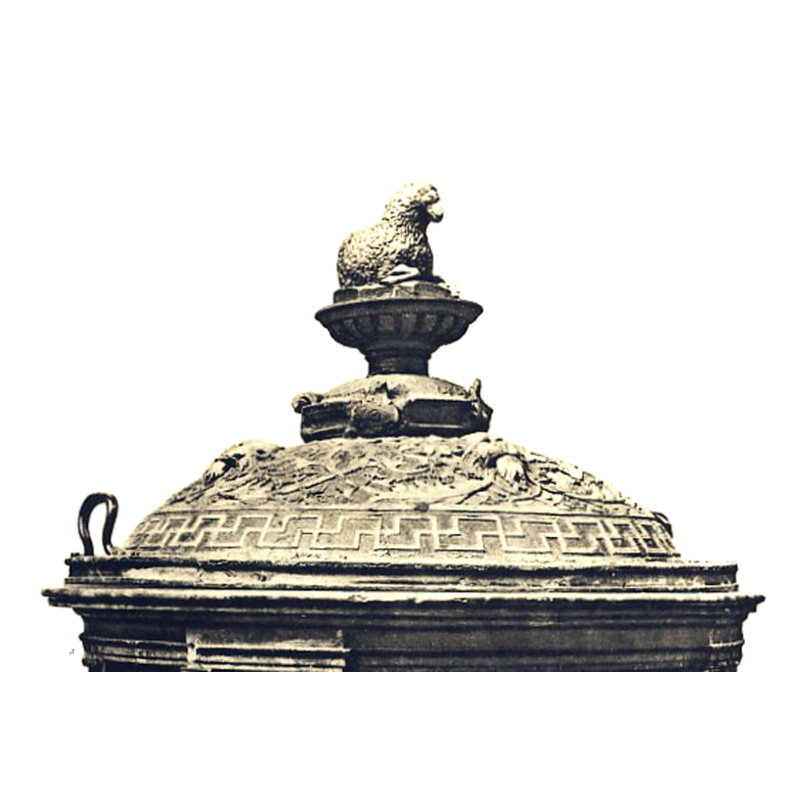Dresden No. 1
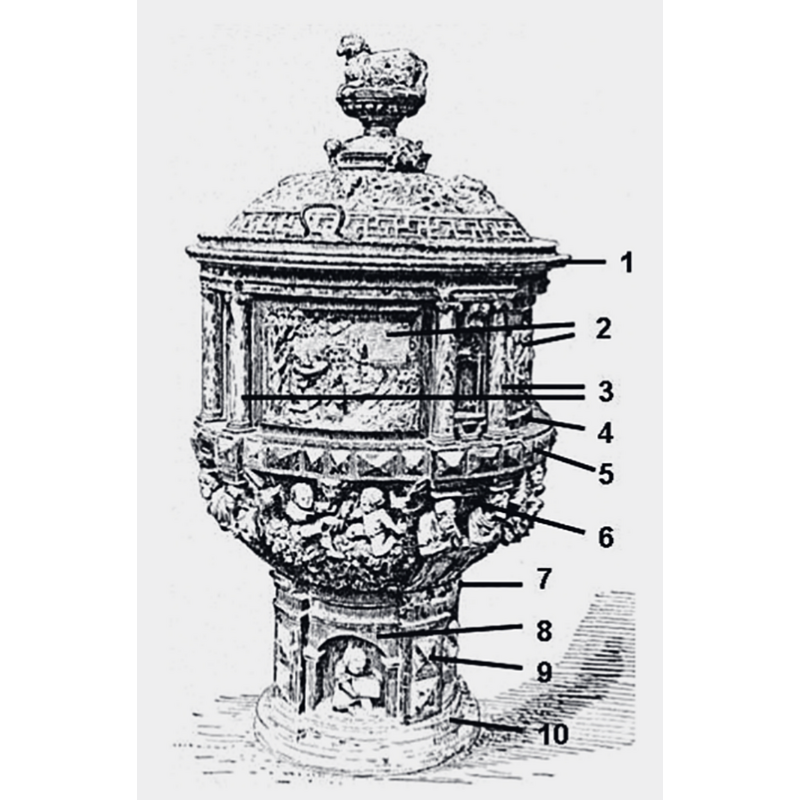
Image copyright © [in the public domain]
Assumed PD
Results: 16 records
New Testament - public life of Christ - baptism of Christ - in the Jordan
Scene Description: [cf. FontNotes]
Copyright Statement: Image copyright © [in the public domain]
Image Source: detail of an illustration in Robert Bruck, 'Die Sophienkirche in Dresden. Ihre Geschichte und ihre Kunstschätze. Keller' (Dresden, 1912) - reproduced in http://de.wikipedia.org/wiki/Schlosskapelle_%28Dresden%29 [accessed 20 May 2013]
Copyright Instructions: PD
Old Testament - Genesis - the Flood and destruction of mankind - story of Noah (Genesis 7:10 - 8:17) - Noah and the ark
Old Testament - Story of Moses - Exodus - crossing of the Red Sea
Scene Description: partially visible in the remains of the basin
Copyright Statement: Image copyright © Paulae, 2009
Image Source: edited version of a photograph taken 128 October 2009 by Paulae [http://de.wikipedia.org/wiki/Datei:Taufstein_Schlosskapelle_Dresden_Hans_Walther_II.JPG] - reworked in http://commons.wikimedia.org/wiki/File:Taufstein_Schlosskapelle_Dresden_Hans_Walther_II-2.JPG [accessed 19 May 2013]
Copyright Instructions: CC-BY-SA-3.0
animal - bird
Scene Description: accompanying the putti
Copyright Statement: Image copyright © [in the public domain]
Image Source: detail of an illustration in Robert Bruck, 'Die Sophienkirche in Dresden. Ihre Geschichte und ihre Kunstschätze. Keller' (Dresden, 1912) - reproduced in http://de.wikipedia.org/wiki/Schlosskapelle_%28Dresden%29 [accessed 20 May 2013]
Copyright Instructions: PD
design element - architectural - niche
Scene Description: [cf. FontNotes]
Copyright Statement: Image copyright © [in the public domain]
Image Source: detail of an illustration in Robert Bruck, 'Die Sophienkirche in Dresden. Ihre Geschichte und ihre Kunstschätze. Keller' (Dresden, 1912) - reproduced in http://de.wikipedia.org/wiki/Schlosskapelle_%28Dresden%29 [accessed 20 May 2013]
Copyright Instructions: PD
design element - architectural - niche or window
Scene Description: arches supported in columns with capitals
Copyright Statement: Image copyright © [in the public domain]
Image Source: detail of an illustration in Robert Bruck, 'Die Sophienkirche in Dresden. Ihre Geschichte und ihre Kunstschätze. Keller' (Dresden, 1912) - reproduced in http://de.wikipedia.org/wiki/Schlosskapelle_%28Dresden%29 [accessed 20 May 2013]
Copyright Instructions: PD
design element - motifs - floral and foliage
Copyright Statement: Image copyright © [in the public domain]
Image Source: detail of an illustration in Robert Bruck, 'Die Sophienkirche in Dresden. Ihre Geschichte und ihre Kunstschätze. Keller' (Dresden, 1912) - reproduced in http://de.wikipedia.org/wiki/Schlosskapelle_%28Dresden%29 [accessed 20 May 2013]
Copyright Instructions: PD
design element - motifs - geometric
Scene Description: adorned with stones [cf. FontNotes]
Copyright Statement: Image copyright © [in the public domain]
Image Source: detail of an illustration in Robert Bruck, 'Die Sophienkirche in Dresden. Ihre Geschichte und ihre Kunstschätze. Keller' (Dresden, 1912) - reproduced in http://de.wikipedia.org/wiki/Schlosskapelle_%28Dresden%29 [accessed 20 May 2013]
Copyright Instructions: PD
human figure
Scene Description: several; in niches [cf. FontNotes]
Copyright Statement: Image copyright © [in the public domain]
Image Source: detail of an illustration in Robert Bruck, 'Die Sophienkirche in Dresden. Ihre Geschichte und ihre Kunstschätze. Keller' (Dresden, 1912) - reproduced in http://de.wikipedia.org/wiki/Schlosskapelle_%28Dresden%29 [accessed 20 May 2013]
Copyright Instructions: PD
human figure - demi-figure
Scene Description: several of them, male and female; one is dressed like a Roman emperor; to his side a Roman matron?
Copyright Statement: Image copyright © [in the public domain]
Image Source: detail of an illustration in Robert Bruck, 'Die Sophienkirche in Dresden. Ihre Geschichte und ihre Kunstschätze. Keller' (Dresden, 1912) - reproduced in http://de.wikipedia.org/wiki/Schlosskapelle_%28Dresden%29 [accessed 20 May 2013]
Copyright Instructions: PD
human figure - putto
Scene Description: in pairs; surrounded by foliage, food, birds...
Copyright Statement: Image copyright © [in the public domain]
Image Source: detail of an illustration in Robert Bruck, 'Die Sophienkirche in Dresden. Ihre Geschichte und ihre Kunstschätze. Keller' (Dresden, 1912) - reproduced in http://de.wikipedia.org/wiki/Schlosskapelle_%28Dresden%29 [accessed 20 May 2013]
Copyright Instructions: PD
view of church exterior - west view
view of font
Scene Description: the reconstructed remains of the font at present
Copyright Statement: Image copyright © Paulae, 2009
Image Source: edited version of a photograph taken 128 October 2009 by Paulae [http://de.wikipedia.org/wiki/Datei:Taufstein_Schlosskapelle_Dresden_Hans_Walther_II.JPG] - reworked in http://commons.wikimedia.org/wiki/File:Taufstein_Schlosskapelle_Dresden_Hans_Walther_II-2.JPG [accessed 19 May 2013]
Copyright Instructions: CC-BY-SA-3.0
view of font and cover
Scene Description: the font ca. 1910
Copyright Statement: Image copyright © [in the public domain]
Image Source: illustration in Robert Bruck, 'Die Sophienkirche in Dresden. Ihre Geschichte und ihre Kunstschätze. Keller' (Dresden, 1912) - reproduced in http://de.wikipedia.org/wiki/Schlosskapelle_%28Dresden%29 [accessed 20 May 2013]
Copyright Instructions: PD
view of font and cover
Scene Description: Source caption: "Abb. 2. Übersichtsdarstellung des Taufsteins mit Verortung der verwendeten Dekorations- und Schmucksteine (Vorlage nach Gurlitt 1903, verändert): 1 – Beckenrand (roter Kalkstein), 2 – Sandsteinreliefs der Kuppa, 3 – Nischen- und Säulenarchitektur (Serpentinit Zöblitz und heller Kalkstein), 4 – Rahmen der Reliefs (Serpentinit Zöblitz), 5 – Fries mit Diamantquadern (Serpentinit Zöblitz, Jaspis, Kalksteine), 6 – Einlagen im Sandstein der Ausladung unter dem Taufbecken (Serpentinit Zöblitz, heller Kalkstein), 7 – Platte aus Zöblitzer Serpentinit, 8 – Fuß (Alabaster), 9 – Diamantquader (roter Kalkstein und Serpentinitbrekzie Verde Antico), 10 – Sockelplatte (roter Kalkstein).
Fig. 2. Sketch of the font with localisation of the used decorative stones and minerals (pattern from Gurlitt 1903, changed): 1 – rim of the basin (red limestone), 2 – sandstone reliefs, 3 – architectural elements (columns, niches – serpentinite from Zöblitz and light limestone), 4 – frame around the reliefs (serpentinite from Zöblitz), 5 – frieze with diamond-point stones (serpentinite from Zöblitz, jasper, limestones), 6 – inlays in the sandstone ornaments below the basin (serpentinite from Zöblitz, light limestone), 7 – slab made of serpentinite from Zöblitz, 8 – foot (alabaster), 9 – diamond-point stones (red limestone and serpentinite breccia Verde Antico), 10 – pedestal (red limestone)."
Copyright Statement: Image copyright © [in the public domain]
Image Source: digital image of an illustration in Heiner Siedel's Dekorationsgesteine und Schmucksteine am Taufstein der Schlosskapelle in Dresden / Decorative and semiprecious stones on the font of the chapel in the Residence Castle in Dresden, in Geologia saxonica 63: 123-135 [www.senckenberg.de/geologica-saxonica] [accessed 29 June 2022]
Copyright Instructions: Assumed PD
INFORMATION
FontID: 08421DRE
Object Type: Baptismal Font1
Museum and Inventory Number: Dresden Schloss Museum
Church/Chapel: [originally from Sophienkirche, later in the Schlosskapelle]
Church Patron Saints: [St. Sophia]
Church Location: Schloßplatz, 01067 Dresden, Germany
Country Name: Germany
Location: Dresden, Sachsen
Directions to Site: The Schlosskapelle is located in the Schloss-Platz, by the S bank of the Elbe river -- Sophienkirche stood on the NE corner of the Postplatz, before its destruction in 1962 on resolution of the party and government of the GDR
Font Location in Church: In the display area of the museum
Date: 1555
Century and Period: 16th century(mid)
Workshop/Group/Artisan: Hans Walther II
Font Notes:
Click to view
An illustration of this font in its original shape appears in Bruck (1912); the font cosists of a cylindrical basin deeply carved with Biblical scenes in window-like frames, one of which is the Baptism of Christ in the Jordan river and a possible the Israelites Crossing of the Red Sea; between these frames are elaborate niches that may have have housed little statuettes;a band of large semi-precious stones separates the basin sides from the underbowl; the underbowl is crowded with humans (putti, demi-figures), foliage and architectural details; the cylindrical pedestal base has several niches or windows, deeply carved with human figures engaged in different activities (drinking, etc.); between the niches, geometrical shapes; mouldings below. The metal (?) font cover is domed-shaped, the lower side decorated with a fret band, the upper part of the dome appears to have scenes on it, and the finial is cup or chalice shaped with a couchant lamb on it; the cover appears to have had handles at opposite ends. The font was badly damaged in the Allied bombings of World War II that destroyed a large part of Dresden. Described and illustrated in Syndram (2001) as the fragmentary remains of the baptismal font originally from the chapel of Dresden Castle; it is believed to be the work of Hans Walther II and dated to 1555; the author describes the remains, which amount to part of the basin sides, most of the underbowl, and part of the pedestal base; the materials listed in the source are: sandstone, alabaster, jasper and serpentine stone. Described and illustrated in Heiner Siedel's Dekorationsgesteine und Schmucksteine am Taufstein der Schlosskapelle in Dresden / Decorative and semiprecious stones on the font of the chapel in the Residence Castle in Dresden, in Geologia saxonica 63: 123-135 [www.senckenberg.de/geologica-saxonica] [accessed 29 June 2022], where the abstract reads: "In a renewed petrographic investigation of the stone material of the font of the chapel in the Residence Castle in Dresden (1558), contrary
descriptions of the used material in the existing literature were critically examined and partially revised. An interesting new insight was the early use of (regional?) alabaster in the foot of the font by the Dresden sculptor Hans Walther II. At the same time the utilization of serpentinite and jasper from Saxony and the use of light, fine-grained limestone probably from Southern Germany by Hans Walther reflect his early intentions to apply decorative minerals and stones for designing pieces of art. The red limestones in the pedestal as well as in the rim of the basin, most likely coming from Grünau near Wildenfels in Saxony, are additions of a later renovation after 1600. Diamond-point stones on the font’s foot made of the green serpentinite breccia Verde Antico correspond with columns of the same material on the second altar of the chapel in the Residence Castle, erected during a renovation by Klengel 1662. The results demonstrate that investigations of stone materials used on works of art might contribute to better understanding of the object’s history."
COORDINATES
Church Latitude & Longitude Decimal: 51.053661, 13.738433
Church Latitude & Longitude DMS: 51° 3′ 13.18″ N, 13° 44′ 18.36″ E
UTM: 33U 411580 5656549
MEDIUM AND MEASUREMENTS
Material: stone, mixed [cf. FontNotes]
Font Shape: cylindrical (mounted)
Basin Interior Shape: round
Basin Exterior Shape: round
LID INFORMATION
Date: 1555?
Material: metal
Apparatus: no
Notes: [cf. FontNotes]
REFERENCES
Syndram, Dirk, Der Schloss zu Dresden: von der Residenz zu Museum, München, Berlin: Koehler & Amelang, 2001
![[cf. FontNotes]](/static-50478a99ec6f36a15d6234548c59f63da52304e5/compressed/0130519013_compressed.png)


